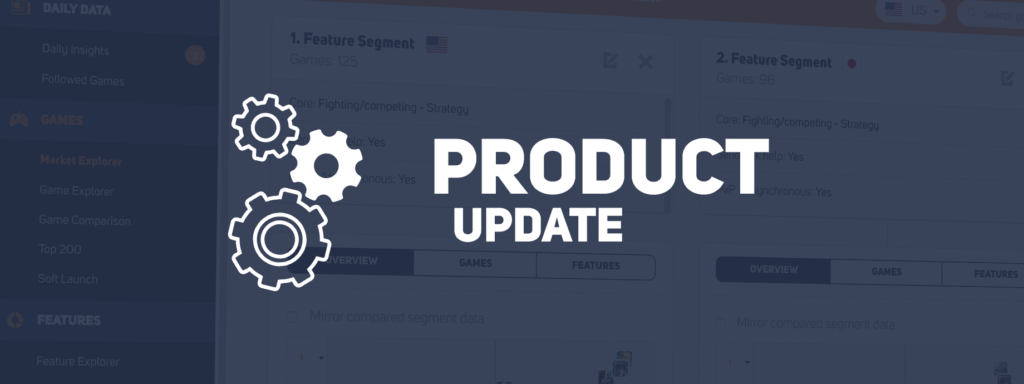Smart developers know the value of data and data-driven approaches to drive growth and increase audience spending in their games. But, in a crowded and competitive market where most app companies have access to roughly the same tracking tools and app store analytics to get more bang for their budget, the pressure is on developers to look elsewhere – and earlier in the app cycle – to build a lasting competitive edge.
Increasingly, it’s the capabilities to design an amazing and addictive user experience – and not how well you can ‘game’ the algorithms – that will move the needle on your mobile game. While games don’t have to have massive traction right out of the gate to be incredibly successful, they have to excite and entice users with a steady flow of new features and mechanics.
It’s a new dynamic that requires developers to build the capabilities to identify and implement the game features and feature sets with the greatest earning (and engagement) potential if they want to stay that all-important step ahead of the competition.
User appetite for new features
What’s more, the seismic shift in F2P business models to “games-as-a-service” forces developers to evolve their game with their audience and their growing appetite for new, cool features. There are huge benefits to embracing a “games-as a service-model” provided you also power it with the right mix of features. It’s precisely the approach that has allowed blockbuster titles like Supercell’s Clash Royale to stay fresh, remain relevant and rocket up the charts.
Since its global launch in March 2016, Clash Royale has introduced a steady stream of new features, ranging from Custom Tournament and Victory Challenge modes to special Clan Battle and Clans Chest events. Satisfied that the new cards, rewards, and events were crowd-pleasers, Supercell upped the ante with Live Spectating and TV Royale Channels, allowing players to see the best battles from any Arena.
However, user appetite for features is not limited to strategy-tactic games like Clash Royale. Casual games users are also primed and prepared to learn new and more complex game mechanics. It’s what is driving fast-moving game studios like Playrix to embrace collecting and building elements in their casual match 3 games Gardenscapes (Features that have earned them rave user reviews, by the way.).
Benchmarking with the best-in-class
Clearly, features play a central role in a successful strategy to acquire and retain users for your game. But rather than waste time and money guessing which features you should implement in your game, you should harness tools that allow you to make decisions based on hard data and high confidence that it will hit your KPIs, not miss them by a mile.
Indeed, data – in the form of reliable market and business intelligence combined with in-depth analysis around the features that are trending and the ones that are failing – is what can make or break your game.
To help developers identify winning features, calculate the revenue potential of feature sets, and even get inspiration for innovative features from games and markets elsewhere, GameRefinery is constantly analyzing the top 180+ features across to the top 200 grossing games, as well as hundreds of games outside the top 200 grossing list. This feature-level analysis equips developers with unique insights to pinpoint and prioritize winning features, ensuring developers focus efforts on improvements that extend their game’s lifespan and increase user engagement.
Hits and misses
On the flip side, a feature level analysis of games from competitors also gives developers an inside track on the features rivals are implementing effectively and alerts them to features that have hit potential. A prime example is gachas, which has become the most popular F2P mechanic in Japan, now sweeping the West. Early on, and before the trend hit the tipping point, we observed the rise of gacha mechanics in Western mobile game markets. In fact, our data showed gachas were a key feature of a significant number of incredibly successful games. Overall, 58% of the top-grossing 100 iOS games in the U.S. feature one or more gachas. Our clients who had games in this genre were able to ride this wave, not be crushed by it.
Of course, spotting the “misses” is as important as predicting the hits. Feature level analysis allowed us to dismiss the mass movement to strict session length restriction mechanics. Market-leading games – including the recent hit game C.A.T.S – aren’t forcing players to make in-app purchases; they embrace a variety of proven and popular game features such as mechanics around collecting.
This and countless other examples show features form the foundation for your game and potentially decide the future of your company. Based on our in-depth examination of analysis of 7K+ games over the last 3 years, we have established that having the right features set – one that matches your target audience and their appetite for game mechanics – is at the core of competitive advantage and commercial success. Specifically, the feature set is responsible for 40-60% of a game’s total revenue potential – and certainly essential to pursuing a “games-as-a-service model.”
Features data doesn’t just lift the lid on what you need to bake into your game to benchmark against the best-in-class and win against your rivals. Factoring features data into your own individual algorithm for success allows you to plan and implement a comprehensive UA budget with the confidence that you have what it takes to drive results and deliver the highest possible returns.
********
This article was originally published in PocketGamer.biz
Interested in a concrete example of how you can utilize GameRefinery and its data to create unique game features? Check out our article on using data & personal skills to make unique features!





















